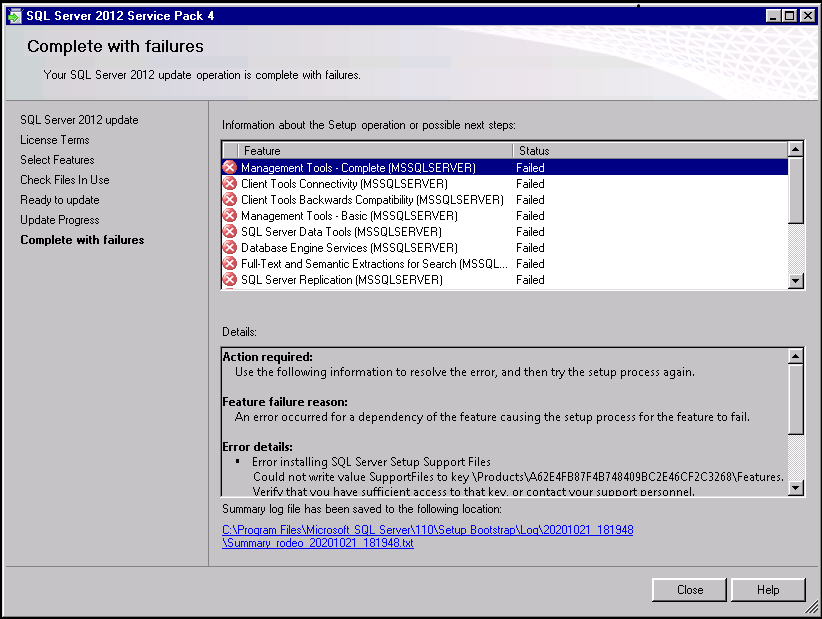Error 1406 installing SQL Server Setup Support Files.
Applies to: SQL Server 2012 Standard Edition
Date created: November 9, 2020.
Problem Description.
I was trying to apply service pack 4 on a SQL Server 2012 instance when I got
the following error message:
Error installing SQL Server Setup Support Files.
Could not write value SupportFiles to key \Products
\A62E4FB87F4B748409BC2E46CF2C3268\Features. System error . Verify that you have
sufficient
access to that key, or contact your support personnel.

On the summary.txt log file, we found the following error:
Overall summary:
Final result: The patch installer has failed to update the following instance:
MSSQLSERVER. To determine the reason for failure, review the log files.
Exit code (Decimal): -2068052610
Start time: 2020-10-21 18:20:05
End time: 2020-10-21 18:25:31
Requested action: Patch
In addition, we found the following error on the SqlSupport_Cpu64_1.txt log
file:
Product: Microsoft SQL Server 2012 Setup (English) -- Error 1406. Could not
write value
SupportFiles to key \Products\A62E4FB87F4B748409BC2E46CF2C3268\Features. System
error .
Verify that you have sufficient access to that key, or contact your support
personnel.
Error 1406. Could not write value SupportFiles to key \Products
\A62E4FB87F4B748409BC2E46CF2C3268\Features. System error . Verify that you have
sufficient
access to that key, or contact your support personnel.
Cause.
The Windows Server operating system resulted to be corrupted. We found the
following errors.
Log Name: System
Source: Service Control Manager
Date: 11/8/2020 5:43:00 PM
Event ID: 7023
Task Category: None
Level: Error
Keywords: Classic
User: N/A
Computer: server.domainname
Description:
The Windows Modules Installer service terminated with the following error:
Insufficient system resources exist to complete the requested service.
Event Xml:
<Event xmlns="http://schemas.microsoft.com/win/2004/08/events/event">
<System>
<Provider Name="Service Control Manager" Guid="{555908d1-a6d7-4695-8e1e-26931d2012f4}"
EventSourceName="Service Control Manager" />
<EventID Qualifiers="49152">7023</EventID>
<Version>0</Version>
<Level>2</Level>
<Task>0</Task>
<Opcode>0</Opcode>
<Keywords>0x8080000000000000</Keywords>
<TimeCreated SystemTime="2020-11-08T21:43:00.189121100Z" />
<EventRecordID>2048815</EventRecordID>
<Correlation />
<Execution ProcessID="556" ThreadID="696" />
<Channel>System</Channel>
<Computer>server.domainname</Computer>
<Security />
</System>
<EventData>
<Data Name="param1">Windows Modules Installer</Data>
<Data Name="param2">%%1450</Data>
</EventData>
</Event>
Log Name: System
Source: Service Control Manager
Date: 10/21/2020 11:34:42 PM
Event ID: 7034
Task Category: None
Level: Error
Keywords: Classic
User: N/A
Computer: server.domainname
Description:
The Microsoft .NET Framework NGEN v4.0.30319_X86 service terminated
unexpectedly. It has done this 3 time(s).
Event Xml:
<Event xmlns="http://schemas.microsoft.com/win/2004/08/events/event">
<System>
<Provider Name="Service Control Manager" Guid="{555908d1-a6d7-4695-8e1e-26931d2012f4}"
EventSourceName="Service Control Manager" />
<EventID Qualifiers="49152">7034</EventID>
<Version>0</Version>
<Level>2</Level>
<Task>0</Task>
<Opcode>0</Opcode>
<Keywords>0x8080000000000000</Keywords>
<TimeCreated SystemTime="2020-10-22T03:34:42.408235800Z" />
<EventRecordID>2046779</EventRecordID>
<Correlation />
<Execution ProcessID="556" ThreadID="2844" />
<Channel>System</Channel>
<Computer>server.domainname</Computer>
<Security />
</System>
<EventData>
<Data Name="param1">Microsoft .NET Framework NGEN v4.0.30319_X86</Data>
<Data Name="param2">3</Data>
</EventData>
</Event>
Log Name: Application
Source: Microsoft-Windows-User Profiles Service
Date: 11/8/2020 11:51:15 PM
Event ID: 1511
Task Category: None
Level: Error
Keywords:
User: domainname\amorillo
Computer: server.domainname
Description:
Windows cannot find the local profile and is logging you on with a temporary
profile. Changes you make to this profile will be lost when you log off.
Event Xml:
<Event xmlns="http://schemas.microsoft.com/win/2004/08/events/event">
<System>
<Provider Name="Microsoft-Windows-User Profiles Service" Guid="{89B1E9F0-5AFF-44A6-9B44-0A07A7CE5845}"
/>
<EventID>1511</EventID>
<Version>0</Version>
<Level>2</Level>
<Task>0</Task>
<Opcode>0</Opcode>
<Keywords>0x8000000000000000</Keywords>
<TimeCreated SystemTime="2020-11-09T03:51:15.678152600Z" />
<EventRecordID>1533634</EventRecordID>
<Correlation />
<Execution ProcessID="880" ThreadID="3084" />
<Channel>Application</Channel>
<Computer>server.domainname</Computer>
<Security UserID="S-1-5-21-1957994488-343818398-682003330-10116" />
</System>
<EventData>
</EventData>
</Event>
Solution.
We decided to perform a side-by-side migration of the SQL Server instance on a
newly configured Windows Server 2016 server, instead of repairing the operating
system.
![[Company Logo Image]](images/SQLCofee.jpg)
